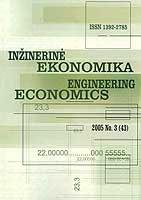Modelling of Strategic Analysis in Strategic Management
Modelling of Strategic Analysis in Strategic Management
Author(s): Sigitas VaitkevičiusSubject(s): Economy
Published by: Kauno Technologijos Universitetas
Keywords: strategic analysis; strategic management; strategic planning; strategic management process; cluster model.
Summary/Abstract: The concept of strategic analysis is understood and defined differently by various authors as well as it is differently positioned in the process of strategic management. Nevertheless, certain logic can be envisaged. In many cases, their conceptions are indirectly related to the context in which they were introduced. The authors who described general principles of strategic management perceived strategic analysis in one way, those who analysed strategic management of small and mediumsized enterprises perceived it in another way and still different perception was held by the authors who analysed strategic planning. Enterprises are very diverse in their possibilities and interests. Some have one employee and are established in the same building where the owner lives; others are multinational companies with tens of thousands of employees and managing property worth billions in several countries. It is obvious that such a situation calls for diversification of strategic analysis in the context of strategic management. Then the question is what the key principles of diversification are, i.e. what determines the choice of strategic analysis model. This article compares various authors’ notions of strategic analysis, highlights their essential differences and suggests an operating concept of strategic analysis in the process of strategic management. The suggested operating process of strategic management was analysed using an opinion and attitude questionnaire. The questionnaire was used to study opinions and attitudes of the managers of organizations of various sizes and activity areas. To achieve statistical significance, the portion of SME managers was reduced to 91 percent, although it comprises 99.7 percent in Lithuania at the moment. In this way the sample of large organizations’ managers was created and strategic analysis in SMEs became comparable to strategic analysis in large organizations.
Journal: Engineering Economics
- Issue Year: 2006
- Issue No: 4 (49)
- Page Range: 37-47
- Page Count: 11
- Language: English

